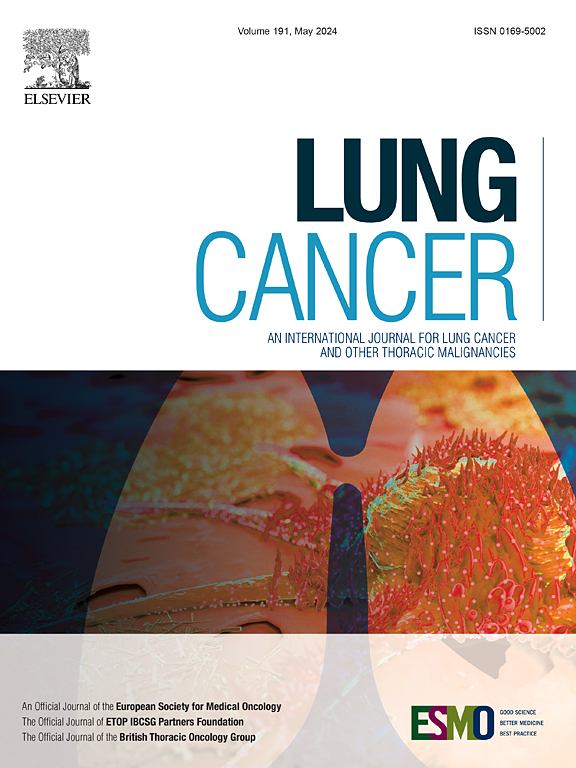肺大细胞神经内分泌癌的流行病学和临床病程:日本肺癌登记研究
IF 4.5
2区 医学
Q1 ONCOLOGY
引用次数: 0
摘要
本研究旨在探讨肺大细胞神经内分泌癌(LCNEC)患者的特点和临床病程,并比较不同类型肺癌的差异。方法本前瞻性研究纳入了来自日本肺癌登记联合委员会(JJCLCR)数据库的11310例LCNEC、小细胞肺癌(SCLC)、鳞状细胞癌和腺癌患者。登记处于2012年1月开放,后续工作于2016年4月完成。结果共80例(0.7%)被诊断为LCNEC。LCNEC与SCLC具有相似的患者特征,其特征是中位年龄为68岁,男性患病率高(93.8%)和吸烟者(97.5%)。在IV期患者中,一线顺铂化疗的最佳总缓解率和疾病控制率在LCNEC为34.8%和43.5%,而在SCLC为60.6%和69.7%。同样,IV期患者一线卡铂化疗的总体缓解率和疾病控制率,LCNEC为29.4%和41.2%,而SCLC为56.1%和68.4%。LCNEC、SCLC、鳞状细胞癌和腺癌的3年生存率分别为14.2%、15.9%、17.8%和27.1%。LCNEC和SCLC的总生存Kaplan-Meier曲线相似,Cox风险分析无统计学意义(风险比0.818,95%可信区间0.611-1.096,p = 0.178)。结论尽管LCNEC和SCLC的患者特征和生存曲线相似,但我们的数据表明,与SCLC相比,LCNEC对一线化疗的总体反应和疾病控制率较低。本文章由计算机程序翻译,如有差异,请以英文原文为准。
Epidemiology and clinical course of large cell neuroendocrine carcinoma of the lung: The Japanese lung cancer registry study
Background
This study aimed to investigate the characteristics and clinical courses of patients with pulmonary large cell neuroendocrine carcinoma (LCNEC) and compare the differences across lung cancer types.
Methods
This prospective study included 11,310 patients with LCNEC, small cell lung cancer (SCLC), squamous cell carcinoma, and adenocarcinoma from the Japanese Joint Committee of Lung Cancer Registry (JJCLCR) database. The registry was opened in January 2012, and the follow-up was completed in April 2016.
Results
In total, 80 patients (0.7 %) were diagnosed with LCNEC. LCNEC shared similar patient characteristics with SCLC, characterized by a median age of 68 years and a high prevalence of men (93.8 %) and smokers (97.5 %). In stage IV patients, the best overall response and disease control rates for first-line cisplatin-based chemotherapy were 34.8 % and 43.5 % for LCNEC but 60.6 % and 69.7 % for SCLC. Similarly, the overall response and disease control rates for first-line carboplatin-based chemotherapy in stage IV patients were 29.4 % and 41.2 % for LCNEC, but 56.1 % and 68.4 % for SCLC. The 3-year survival rates for LCNEC, SCLC, squamous cell carcinoma, and adenocarcinoma were 14.2 %, 15.9 %, 17.8 %, and 27.1 %, respectively. Kaplan–Meier curves of overall survival showed similarity between LCNEC and SCLC, with no statistical significance in the Cox hazard analysis (hazard ratio 0.818, 95 % confidence interval 0.611–1.096, p = 0.178).
Conclusions
Although patient characteristics and survival curves were similar in LCNEC and SCLC, our data demonstrate that LCNEC had inferior overall response and disease control rates in response to first-line chemotherapy compared to SCLC.
求助全文
通过发布文献求助,成功后即可免费获取论文全文。
去求助
来源期刊

Lung Cancer
医学-呼吸系统
CiteScore
9.40
自引率
3.80%
发文量
407
审稿时长
25 days
期刊介绍:
Lung Cancer is an international publication covering the clinical, translational and basic science of malignancies of the lung and chest region.Original research articles, early reports, review articles, editorials and correspondence covering the prevention, epidemiology and etiology, basic biology, pathology, clinical assessment, surgery, chemotherapy, radiotherapy, combined treatment modalities, other treatment modalities and outcomes of lung cancer are welcome.
 求助内容:
求助内容: 应助结果提醒方式:
应助结果提醒方式:


